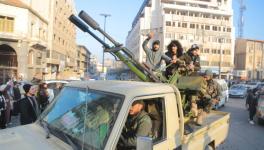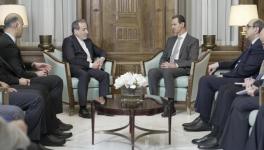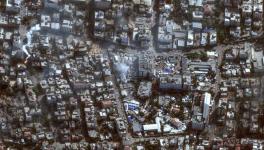Why the Idea of Cracking Syria into Pieces would be America's Latest Imperial Disaster

Syrian refugees in Lebanon staying in small cramped quarters, 3 September 2012
Far away from Syria, in the air-conditioned offices of think tanks and war rooms sit the intellectuals of our current order. They gaze at maps of Syria – a country to which they have no emotional ties or on whose land they might not have walked. They are not the first men driven by the fantasy of seizing resources and solving problems by drawing new borders. They follow in the 1916 tradition of the British diplomat Mark Sykes and his French counterpart François Georges-Picot, who carved up Ottoman Syria into zones of influence for their respective countries. A hundred years later, the men who follow Sykes and Picot couch their imperial ambitions in humanitarian rhetoric. Their lines begin with ‘safe zones’ and then move to a confederation and finally to a dismembered Syria. Partition, guaranteed by American airpower and troops, they argue, is the solution to the Syrian crisis.
Deeply battered by the civil war, with half its population displaced and over half a million dead, Syria is weakened to the point of virtual collapse. The fall of the government of Bashar al-Assad in Damascus would not be – as many of these intellectuals of the American Empire agree – the best possible outcome. ‘Realistically,’ as Michael O’Hanlon of the Brookings Institute put it in 2015, ‘the replacement of Assad’ does not ‘appear within reach’ given the lack of palatable alternatives. Moderate forces – as far as the US determines – are simply not available. Therefore, the ouster of Assad in a precipitous way is considered foolhardy.
Instead of removing Assad, then, the United States should – argues O’Hanlon – push for the establishment of ‘one or two safe zones in relatively promising locations,’ backed by ‘perhaps 1,000 American military personnel.’ In these ‘safe zones, local forces – moderates, it is hoped – could be trained to put pressure on Assad’s government. ‘Ultimately, and ideally,’ O’Hanlon argues, ‘some of the safe zones might merge together as key elements in a future con-federal arrangement.’ This dynamic could very well lead to the ‘outright partition of the country if necessary.’ The partition is envisaged along the lines of sect and ethnicity – a Sunni zone, an Alawite zone, and a Kurdish zone. O’Hanlon calls this ‘deconstructing Syria.’
In a recent column, New York Times’ Thomas Friedman muses over the possible futures for Syria. ‘The least bad solution is a partition of Syria,’ Friedman suggests, ‘and the creation of a primarily Sunni protected area – protected by an international force, including, if necessary, some US troops.’ The gap between O’Hanlon and Friedman is merely in that the former recognizes that in the large mixed cities of Damascus and Aleppo, Hama and Homs, a partition would not be easy. ‘Prudence would have to be the watchword,’ writes O’Hanlon.
Neither O’Hanlon nor Friedman – both influential voices in Washington, DC – seem bothered by their imperial gestures. They are quite happy to speak for Syrians, to offer tutelage to Syria which cannot seem to define its own destiny. These are men who will speak of democracy and human rights when it suits them, but then transform just as easily into imperial bureaucrats with their crayons ready to draw lines on someone else’s map.
The influence of these men can be felt quite palpably in the corridors of power. Late last year, CIA Director John Brennan said quite casually, ‘I don’t know whether or not Syria and Iraq can be put back together again. There’s been so much bloodletting, so much destruction, so many continued, seething tensions and sectarian divisions.’ The outcome of this, he suggested, is the partition of Syria. Former US Ambassador to Syria Robert Ford has said that there is already an ‘emerging partition’ of Syria into six zones leading to the ‘Somalization of Syria.’ Amos Gilad, the Strategic Advisor to the Israeli Defense Ministry and well-regarded in US intelligence circles, said, ‘Syria has reached its end.’ They – quite cavalierly – call for the dismemberment of the country.
Last month, before the US strikes on a government airfield, US Secretary of State Rex Tillerson suggested that once ISIS is removed from the northern Syrian city of Raqqa, it would be ‘governed by local forces’ with US backing. What is being considered is that the US would create – in northern Syria – an analogous development to the Kurdistan Regional Government, which is autonomous of the Iraqi government. This statement was made in Turkey, where there is fear of a Syrian Kurdish state on its border. Turkey is not bothered by the break-up of Syria. What it fears is the concrete reality that this fracturing shall produce a Syrian Kurdish autonomous region with US support long the length of its southern border. Even here Turkish sentiments are over-read. Last November, US General Joseph Dunford and Turkish General Hulusi Akar agreed that ‘the coalition and Turkey will work together on the long-term plan for seizing, holding and governing Raqqa.’ This means that the US and the Turks would adopt this region, with the Turks eager to make the Kurds marginal to their occupied zone.
In sum, all the major players who speak the syrupy language of democracy are quite willing to undemocratically plan for the dismemberment of Syria.
Weaken Syria To Weaken Iran.
Iran, since 1979, has confounded the West and its West Asian allies – Israel and Saudi Arabia. The point for these powers has been to find a mechanism to weaken Iran. Saudi Arabia and the West backed Iraq’s long war against Iran precisely to hem in the Islamic Republic.
In 1979, right after Iran’s Revolution, US embassy official Talcott Seelye wrote from Damascus that his government should exaggerate the Alawite hold on the Syrian state so as to break the legitimacy of Hafez al-Assad, the father of the current president. It was important to get rid of Assad, Seelye wrote, to dent Iran’s role in the region. ‘We are inclined to the view that his days are numbered,’ Seelye wrote, even if by ‘the assassination of Assad.’ Although there is not really an Alawite control over the government, Seelye noted, ‘perception is more important than reality.’
During the Iran-Iraq war (1980-88), the United States wished to hit Syria as a way to weaken Iran. In a revealing cable from 1983, CIA chief Graham Fuller urged his paymasters to bring ‘real muscle to bear against Syria.’ Fuller suggested that ‘the US should consider sharply escalating military threats against Syria from three border states hostile to Syria: Iraq, Israel and Turkey.’ He hoped that if these countries simultaneously attacked Syria, it would weaken its position and its prestige. If Syria’s position was dented, Fuller argued, Iran would be forced ‘to reconsider bringing the war to an end.’ What is important is that the regional countries – such as Iraq – ‘still need to remain on guard against Iranian influence and power throughout the Gulf.’ Hitting Syria would weaken Iran. That was the posture in 1983 as it was in 1979 and as it is today.
Twenty years later, in 2006, the US political officer in Damascus, William Roebuck, wrote that his country should join with Saudi Arabian intelligence to stoke fears of sectarianism in the country. Their stick would be to suggest to the Sunni community that Iran was promoting a Shiite agenda in Syria. Roebuck’s cable reveals the continuation of fear mongering around Iran to increase sectarian feeling to weaken Syrian society and the state. ‘There are fears in Syria,’ Roebuck wrote, ‘that the Iranians are active in both Shia proselytizing and conversion of, mostly poor, Sunnis.’ What is startling is that Roebuck then conceded that this is ‘often exaggerated.’ The Americans, Roebuck said, against all evidence, should join with the Saudis to ‘better publicize and focus regional attention to this issue.’
The evidence actually showed that Saudi preachers had entered Syria in large numbers and they had established themselves in the slums. It was in these mosques that they preached virulently sectarian rhetoric and prepared society for the outbreak of sectarian violence. This is precisely what overran Syria in 2011. Roebuck advised his paymasters to encourage splits in the military, advised the Gulf Arabs to stop investing in Syria and encouraged any mischief that would deprive the regime of any support. In other words, Roebuck insisted on preparing the terrain for regime change which would harm – as US intelligence openly said a decade ago – both the Lebanese political-military group Hezbollah and Iran.
Two years ago, the US State Department noted in a memorandum, ‘The best way to help Israel deal with Iran’s growing nuclear capability is to help the people of Syria overthrow the regime of Bashar Assad.’ Fear of Iran saturates this document. The basic argument is that Iran has its grip on West Asia through Syria and into Hezbollah. These have to be brought to heel. If Assad’s government falls, then Iran’s conduit to Hezbollah would break. It was – therefore – essential to overthrow Assad. This has nothing to do with the Syrian people or their needs, but everything to do with the Washington and Tel Aviv’s hallucinations about Iranian power. The fall of Assad, the US diplomats calculated, would mean that ‘Iran would no longer have a foothold in the Middle East from which to threaten Israel and undermine stability in the region.’
If Assad falls and a new – perhaps radical Islamist – regime comes to power in Damascus, how would this help Israel? A US intelligence official told me this week that the word of this period is ‘Yugoslavia.’ The break-up of Yugoslavia, he said, left behind minor states with no regional power. Balkanization, he said with a smile, would be the appropriate solution for Syria. Break it up and Iran would lose its foothold and no powerful state would remain on Israel’s border to pose a threat. Israel could permanently claim the Golan Heights, a US-backed state would emerge on the Syrian border, Jordan could help itself to the totality of the Hawran plateau, an Alawite state would take the coastal plain, leaving a series of Sunni states from the al-Ghab valley to the Hamad desert. A weak Syria would be easy to dominate.
Mischief surrounds Syria. Partition is seen as a way to destroy that state and offer Israel relief on its borders with Syria and Lebanon. The rights and ambitions of the Syrian people are irrelevant to these plots and schemes.
Disclaimer: The views expressed here are the author's personal views, and do not necessarily represent the views of Newsclick.
Cover Photo Credit: By Voice of America News: Margaret Besheer reports from the northern Lebanese city of Tripoli; "Syrian Refugees Seek Out Smugglers". [Public domain], via Wikimedia Commons
Get the latest reports & analysis with people's perspective on Protests, movements & deep analytical videos, discussions of the current affairs in your Telegram app. Subscribe to NewsClick's Telegram channel & get Real-Time updates on stories, as they get published on our website.
























